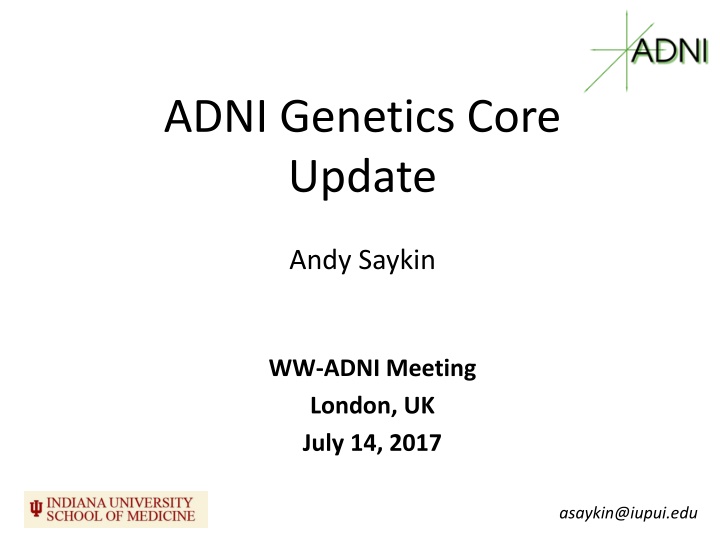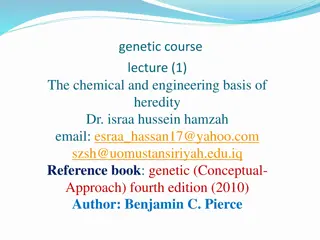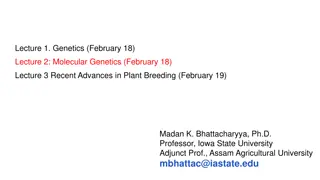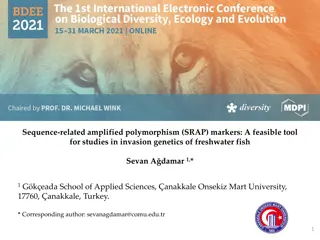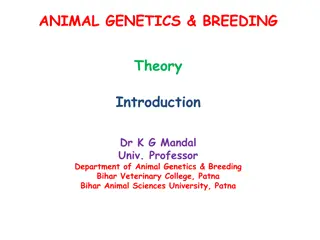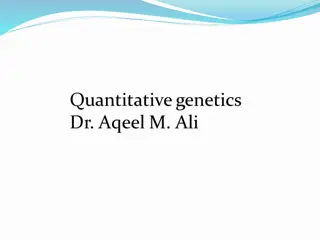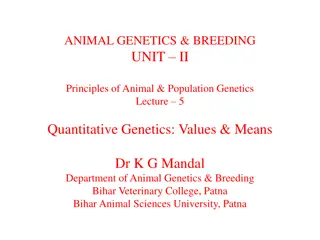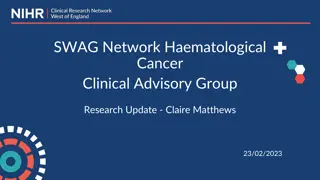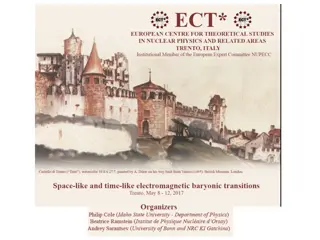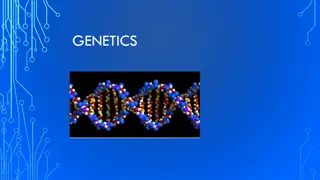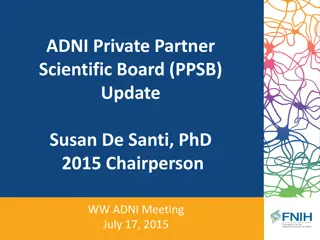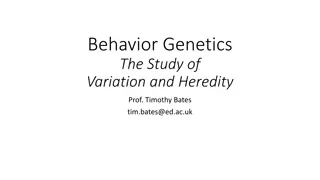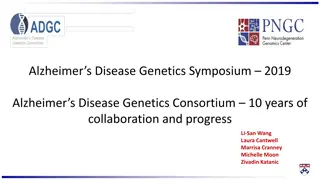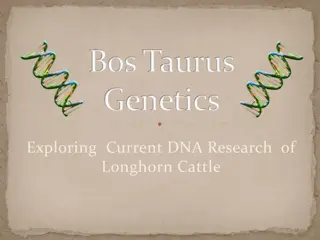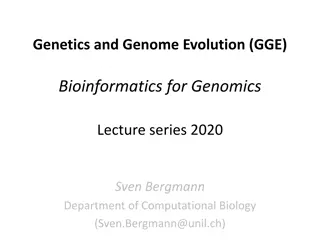Advances in ADNI Genetics Research and Studies Update
Explore the latest advancements in ADNI genetics research, including updates on sample collections, longitudinal DNA and RNA studies, pathway analysis, genetic signal to therapeutics, use of genetic data, and publications on ADNI endophenotypes. The content also covers the most frequently reported genes in manuscripts using ADNI genetic data from 2008 to 2016.
Download Presentation

Please find below an Image/Link to download the presentation.
The content on the website is provided AS IS for your information and personal use only. It may not be sold, licensed, or shared on other websites without obtaining consent from the author.If you encounter any issues during the download, it is possible that the publisher has removed the file from their server.
You are allowed to download the files provided on this website for personal or commercial use, subject to the condition that they are used lawfully. All files are the property of their respective owners.
The content on the website is provided AS IS for your information and personal use only. It may not be sold, licensed, or shared on other websites without obtaining consent from the author.
E N D
Presentation Transcript
ADNI Genetics Core Update Andy Saykin WW-ADNI Meeting London, UK July 14, 2017 asaykin@iupui.edu
Overview and 2017 Updates ADNI-3 sample collection (banked at NCRAD) Longitudinal DNA & RNA (12 new, 79 continuing) Changes in ADNI-3 include PBMC and RBC collection Use of genetic data from ADNI (L. Shen et al, IU) WGS mtDNA variant calls dataset (K. Kauwe, BYU) WGS analysis collaboration with IBM/Watson via ADSP Cognitive subtypes as endophenotypes (P. Crane, UW) MODEL-AD: Model systems U54 (IU/JAX/Sage) Analyses w/ AD Metabolomics Consortium (next) New longitudinal epigenetics data projects telomere length and DNA methylation (w/PPSB WG)
Conceptual Foundation Path from genetic signal to targeted therapeutics (applications to drug discovery and development) Understand biological pathway Identify biomarkers Understand underlying mechanism Develop therapeutic hypothesis Identify patients most likely to benefit Identify causal gene underpinning pathogenesis Discover loci/genes robustly associated with relevant trait Common variant associations Mapping / Sequencing Biomarker development Molecular pharmacology Gene-centric phenome scans Rare variant associations Tissue expression Molecular epidemiology Assay development iPSC and related eQTL, pQTL, mQTL Monogenic disorders Cell-based perturbation Clinical trial samples In-vitro functional assessment Pathway analysis Family-based Mechanistic models Gene editing Clinical imaging Target discovery and qualification Understanding disease biology Stratification & enrichment Core Report Alzheimer s & Dementia 11 (2015) 792-814 http://www.alzheimersanddementia.com/article/S1552-5260(15)00177-6/pdf
Genetics studies Using ADNI Endophenotypes: Publications Using ADNI Genetic Data (2008 2016) Year Pubs 2008 2 2009 9 2010 38 2011 36 2012 60 2013 69 2014 99 2015 78 2016 98 Yao et al, AAIC 2017; Shen et al, Brain Imaging Behav 2014; Saykin et al, Alzheimers Dement 2015 Updated: 4/2017
Most frequently reported genes in manuscripts using ADNI genetic data (2008 2016) Updated: 4/2017 Yao et al, AAIC 2017; Shen et al, Brain Imaging Behav 2014; Saykin et al, Alz & Dement 2015
title 1. Strategies to decrease heterogeneity Selecting patients with baseline measurements in a narrow range (decreased inter-patient variability) and excluding patients whose disease or symptoms improve spontaneously or whose measurements are highly variable (less intra-patient variability). 2. Prognostic enrichment strategies choosing patients with a greater likelihood of having a disease-related endpoint event (for event-driven studies) or a substantial worsening in condition (for continuous measurement endpoints); increase absolute effect between groups. 3. Predictive enrichment strategies choosing patients more likely to respond to the drug treatment than other patients with the condition being treated. Such selection can lead to a larger effect size (both absolute and relative) and permit use of a smaller study population. FDA, 2012
Increasing Studies of Polygenic Risk Scores Mormino, E.C., et al., Polygenic risk of Alzheimer disease is associated with early- and late-life processes. Neurology, 2016. 87(5): p. 481-8. Hohman, T.J., et al., Discovery of gene-gene interactions across multiple independent data sets of late onset Alzheimer disease from the Alzheimer Disease Genetics Consortium. Neurobiol Aging, 2016. 38: p. 141-50. Gaiteri, C., et al., Genetic variants in Alzheimer disease - molecular and brain network approaches. Nat Rev Neurol, 2016. 12(7): p. 413-27. Yokoyama, J.S., et al., Decision tree analysis of genetic risk for clinically heterogeneous Alzheimer's disease. BMC Neurol, 2015. 15: p. 47. Martiskainen, H., et al., Effects of Alzheimer's disease-associated risk loci on cerebrospinal fluid biomarkers and disease progression: a polygenic risk score approach. J Alzheimers Dis, 2015. 43(2): p. 565-73. Escott-Price, V., et al., Common polygenic variation enhances risk prediction for Alzheimer's disease. Brain, 2015. 138(Pt 12): p. 3673-84. Desikan, R.S., et al., Genetic assessment of age-associated Alzheimer disease risk: Development and validation of a polygenic hazard score. PLoS Med, 2017. 14(3): p. e1002258.
Polygenic Hazard Score (Desikan et al 2017) - Based on IGAP GWAS data from 17,008 AD cases & 37,154 controls - Assoc. with HIP & ERC MRI in ADNI Fig 4. Annualized incidence rates showing the instantaneous hazard as a function of polygenic hazard score percentile and age. Desikan, R.S., et al., Genetic assessment of age-associated Alzheimer disease risk: Development and validation of a polygenic hazard score. PLoS Med, 2017. 14(3): p. e1002258.
Cognitively-defined Subgroups Across Cohorts R01 AG 042437 P. Crane et al Memory most common overall, followed by language Isolated substantial language deficits quite marked in MAP and especially ROS Too few with isolated substantial executive functioning deficits for genetic analyses Multiple domains more common in MAP and ROS than in ADNI or ACT
Genetics of Subtypes APOE: Proportion with 1 4 alleles Next Steps: Work underway to analyze IGAP SNPs enriched in each phenotypic subgroup Paul Crane et al, EPAD consortium, unpublished data
Model Organism Development and Evaluation for Late-onset Alzheimer s Disease (MODEL-AD) Contact PI: Bruce Lamb MPIs: Carter, Howell & Territo ADNI contributes target nominations & characterization MODEL-AD is creating organisms based on ADNI reports Website: https://Model-AD.org Contact: ModelAD@iupui.edu Data: https://www.synapse.org/#!Synapse:syn2580853/wiki/409840
Working Toward a Systems Biology of AD Genetics Core Saykin et al Alzheimer s & Dementia 11 (2015) 792-814
ADNI Epigenetics Work in Progress DNA Methylation and Telomere Length Assays Data and QC Completed April 2017 APOE 4 positive (N,%) Study Design Age (years; Mean, SD) Male (N, %) Cross-sectional (All Individuals)* Cognitively Nornal (n=221) 76.27 (6.63) 111 (50%) 57 (26%) Mild Cognitive Impairment (n=335) 72.58 (7.82) 188 (56%) 153 (46%) Alzheimer's Disease (n=93) 77.19 (7.69) 60 (65%) 63 (68%) Longitudinal design* Cognitively Nornal (n=195) 75.96 (6.54) 97 (50%) 50 (26%) Mild Cognitive Impairment (n=283) 72.23 (7.73) 157 (55%) 117 (41%) Alzheimer's Disease (n=93) 77.19 (7.69) 60 (65%) 63 (68%) Pre-/post-conversion MCI to AD (n=110) 74.5 (7.89) 62 (56%) 71 (65%) NL to AD (n=10) 78.8 (4.05) 7 (70%) 4 (40%) NL to MCI (n=42) 78.71 (6.9) 21 (50%) 13 (31%) * 80 cross-sectional samples were included Selection criteria: WGS & GWAS, RNA profiling, > 2 year clinical follow-up, MRI and PET imaging data; converters, longitudinal DNA availability (except 80 cross sectional)
Longitudinal DNA Methylation Project AD is heritable but DNA sequence only explains a portion of the risk. Extreme example: MZ twins discordant for AD. Epigenetics addresses gene x environment interaction. DNA methylation is a key epigenetic mechanism influencing gene expression with CpG islands as enriched sites. In AD, increasing attention in brain tissue with some limited observations in blood. Longitudinal ADNI blood samples are ideal to investigate dynamic changes related to biomarkers. C. Bock (Max Planck Institute for Informatics) Project is a collaboration of the core and PPSB members: AbbVie, J&J and Biogen supported the Illumina Epic arrays, reagents. Assays were run at AbbVie which also provided and bioinformatics support. Data are posted on LONI.
Telomere Length Project Telomere shortening has been shown to strongly correlate with increasing age in humans (Ren et al 2009). Related to cellular senescence, oxidative stress, mitochondrial dysfunction, inflammatory processes and DNA replication failure. Marker of biological aging associated with pollution, smoking, stress, obesity, diet, asthma, diabetes, cardiovascular events, dementia and mortality.
Telomere Study Visit Data 1719 unique IDs and 199 technical replicates passed QC and were included in the unblinded data V1 N=653 V2 N=569 V3 N=450 V4 N=38 (July 2017 Update: Analysis indicated that initial core lab assays had an instrument issue and assays are being selectively repeated; an adjusted new data set will posted on LONI asap) V5 N=9
Plans and Key Future Directions Work with interested parties to secure resources for WGS, transcriptome and epigenetic profiling of ADNI s longitudinal DNA and RNA samples (e.g., Watson/ADSP) Continue AD systems biology research with ADMC, AMP-AD/MOVE-AD, and other partners Facilitate replication studies with other cohorts Collaborate with academic and industry partners on molecular and functional validation follow-up studies including the IU/JAX/Sage MODEL-AD U54 Collaborate with the Neuropathology Core to relate differential pathological features to genetic variation
Genetics Core/Working Groups Indiana University Imaging Genomics Lab Andrew Saykin (Leader) Li Shen (co-Leader) Liana Apostolova Sungeun Kim Kwangsik Nho Shannon Risacher Kelly Nudelman National Cell Repository for AD Tatiana Foroud (co-Leader) Kelley Faber Core Collaborators/Consultants Steven Potkin (UCI; co-Leader) Robert Green (BWH) Paul Thompson (USC) Rima Kaddurah-Daouk (Duke)** ** AD Metabolomics Consortium Other Collaborators RNA and other NGS Projects: Keoni Kauwe (BYU) mtDNA Yunlong Liu (Indiana) mRNA Epigenetics Working Group (PPSB): Wade Davis (AbbVie) Jeffrey Waring (AbbVie) Qingqin Li (J&J) Karol Estrada (Biogen) PPSB Working Groups Aparna Vasanthakumar (AbbVie)* PPSB Chairs FNIH Team * Genetics Core Liaison & Epigenetics WG Systems Biology Working Group 2017
